
How have Americans shown civic virtues throughout history?
- Subject:
- Social Science
- Social Studies
- Material Type:
- Lesson Plan
- Provider:
- Bill of Rights Institute
- Date Added:
- 09/12/2022
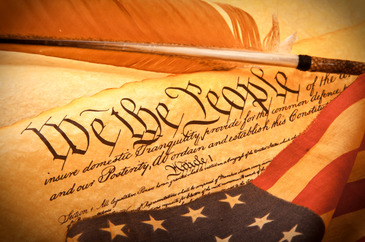
This collection includes educational resources to help educators teach about the United States Constitution.

How have Americans shown civic virtues throughout history?
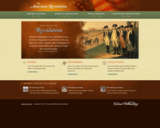
America's independence from Great Britain was a decisive turning point in world history. Join us to explore the causes, character, and consequences of an American Revolution that continues to shape lives around the globe. This site is a virtual museum experience. Explore the American Revolution by timeline, people, and multimedia.
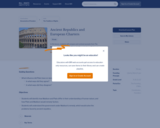
In this lesson, students will compare and contrast excerpts from The Republic of Plato and selected Federalist Papers by James Madison to determine in what ways Madison agreed and disagreed with Plato, regarding human nature the proper role of government in a society. What influence did Plato have on James Madison and the writers of the Constitution? In what ways did they agree? In what ways did they disagree?

A challenging, fun card game that helps students learn about their rights under the Bill of Rights, the first 10 amendments to the Constitution. The game offers three levels of play: Easy, Normal, Difficult.

What is the relationship between the Declaration of Independence and the Constitution? How do these Founding documents reflect common republican principles?

Use this Lesson following The Ratification Debate on the Constitution Narrative.

Use this lesson after reading The Constitutional Convention Narrative and/or the Constitutional Convention Lesson.

In 1777, the Second Continental Congress adopted the Articles of Confederation. The objectives of this activity are: Students will analyze the provisions of the Articles of Confederation. Students will determine why individuals such as George Washington expressed a growing concern over government’s inadequacies, and why these concerns were expressed by and heightened after events such as Shays’s Rebellion. Students will explain why there was a growing call for creating a strong central government and the rationales for the various arguments.

Articles of Confederation- A brief description of the AofC and some short videos.
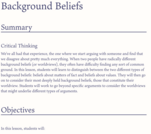
We've all had that experience, the one where we start arguing with someone and find that we disagree about pretty much everything. When two people have radically different background beliefs (or worldviews), they often have difficulty finding any sort of common ground. In this lesson, students will learn to distinguish between the two different types of background beliefs: beliefs about matters of fact and beliefs about values. They will then go on to consider their most deeply held background beliefs, those that constitute their worldview. Students will work to go beyond specific arguments to consider the worldviews that might underlie different types of arguments.
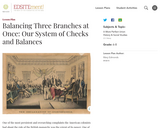
Learn about the checks and balances system of the three branches of the U.S. government.
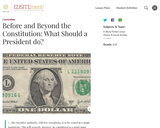
In this curriculum unit, students look at the role of President as defined in the Constitution and consider the precedent-setting accomplishments of George Washington.
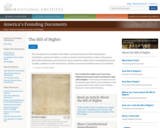
The Constitution might never have been ratified if the framers hadn't promised to add a Bill of Rights. The first ten amendments to the Constitution gave citizens more confidence in the new government and contain many of today's Americans' most valued freedoms.
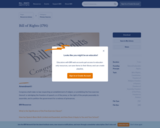
The first 10 amendments to the Constitution make up the Bill of Rights. James Madison wrote the amendments, which list specific prohibitions on governmental power, in response to calls from several states for greater constitutional protection for individual liberties. For example, the Founders saw the ability to speak and worship freely as a natural right protected by the First Amendment. Congress is prohibited from making laws establishing religion or abridging freedom of speech. The Fourth Amendment safeguards citizensâ" right to be free from unreasonable government intrusion in their homes through the requirement of a warrant.

This lesson builds upon prior knowledge of the United States Constitution and the Bill of Rights by asking students to think critically about the issues and philosophies central to both. Through investigation and debate, students are asked to question why certain rights were added to the
Constitution and why others were not. Such a discussion will encourage students to synthesize multiple historical and contemporary perspectives about their rights to decide if, in today’s world, we
need different rights, if our rights are complete the way they are, or if the existing ones need change.

The first ten amendments to the United States Constitution, adopted through ratification, are collectively referred to as the Bill of Rights. As the first nine outline fundamental guarantees to the citizenry and the tenth reserves some governmental powers to the state governments, the Bill of Rights establishes limitations on the scope of the federal government. In this lesson, students will explore the history of the Bill of Rights and the meaning of the amendments included in the document through videos and activities.

Rap song on the Bill of Rights, hosted by Smart Songs, an educational music group, creating songs about history, social studies, geography, and science---providing kids and teachers with content that makes learning fun. ABC News Los Angeles and The Boston Globe have described the group as the current version of Schoolhouse Rock.

In this lesson, students will learn about the individual rights that are included in the Bill of Rights and current issues relating to them. Students will use C-SPAN Classroom's Constitution Clips to explore what each of these rights mean and determine how these rights apply to current events in America. This lesson works well with classes with one-to-one devices or in flipped classrooms.

Join an American Indian Interpreter as they share how the founding fathers looked to native governments when establishing their new republic.

Students will explore the vice of greed in civil society in this lesson on civic virtue. Students will examine "Boss" Tweed and his corrupt New York political machine, how the vice of greed affected politics and civil society, through a historical narrative, discussion guide, and contemporary political cartoons by Thomas Nast. Students will also analyze vice by examining its opposite with contribution and philanthropy.